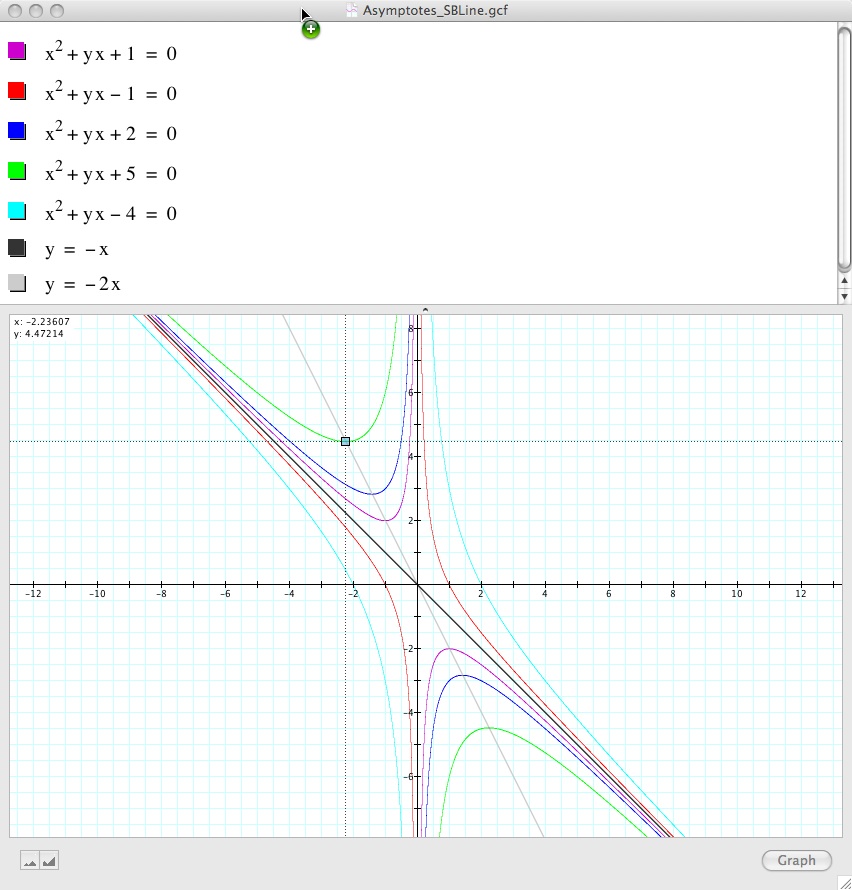

A concise and condensed analysis of the quadratic equation ![]()
(I worked on the 5th write-up for a few days and made it into electronic version on Oct.12, 2009)
Chen Tian
Let's observe the curve of the equation ![]() when n (real number) changes in the interval [-5,5].
when n (real number) changes in the interval [-5,5].
We can use the control bar to observe a specific curve desided by a specific value of n. Especially when n=0 the equation will turn out to be y=-x whose graph is a line passing through the origin with slop -1. So I guess the asymtote of those curves is y=-x, at least, it looks like.
Let's try to figure out what exactly the commom asymtotes of those curves of the equations ![]() is as follows.
is as follows.
We transform ![]() into
into  . But we know x as an denominater cannot be 0, so one of the common asymtotes is the y-axis. Furthermore, if we transform
. But we know x as an denominater cannot be 0, so one of the common asymtotes is the y-axis. Furthermore, if we transform ![]() into
into , then we will see that when x approaches to infinity, 1/x approaches 0, and then y approaches to -x. So the other asymtote, a slant/oblique one, is y=-x.
, then we will see that when x approaches to infinity, 1/x approaches 0, and then y approaches to -x. So the other asymtote, a slant/oblique one, is y=-x.
If we connect all the points with smallest y-value (when y is positve) or the biggest y-value (when y is negative) of each pair of hypobola we will see they are all on the line y=-2x. Why is it that?
In calculus, the derivative ![]() of the dependent variable about the independent variable at one point is the slop of the tangent line of the graph at that point. When
of the dependent variable about the independent variable at one point is the slop of the tangent line of the graph at that point. When ![]() = 0, it means the slop at that point is 0 or the tangent line at that point is parallel to the x-axis. Now we compute the derivate of y from the equation
= 0, it means the slop at that point is 0 or the tangent line at that point is parallel to the x-axis. Now we compute the derivate of y from the equation ![]() :
:  . Let
. Let ![]() =0 in this equation, then we get 2x+y+0=0, i.e., y=-2x, which is just what we want. If we express
=0 in this equation, then we get 2x+y+0=0, i.e., y=-2x, which is just what we want. If we express ![]() in terms of x when n is positive, we will get
in terms of x when n is positive, we will get  , and then let
, and then let ![]() =0, we get
=0, we get ![]() or
or ![]() , which are the corresponding x-values of the smallest y-value (when y is positve) or the biggest y-value (when y is negative)of each pair of hypobola, for example the x-value of the lowest point of the hypobola in the second qudrant is
, which are the corresponding x-values of the smallest y-value (when y is positve) or the biggest y-value (when y is negative)of each pair of hypobola, for example the x-value of the lowest point of the hypobola in the second qudrant is ![]() which is approximately -2.236.
which is approximately -2.236.
Isn't it cool? We check this up with the following example.

Return to my homepage for EMAT 6680